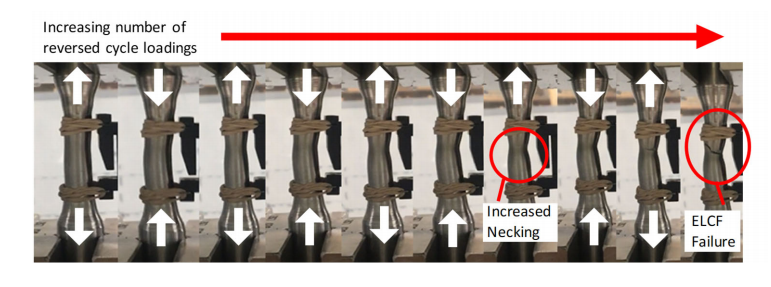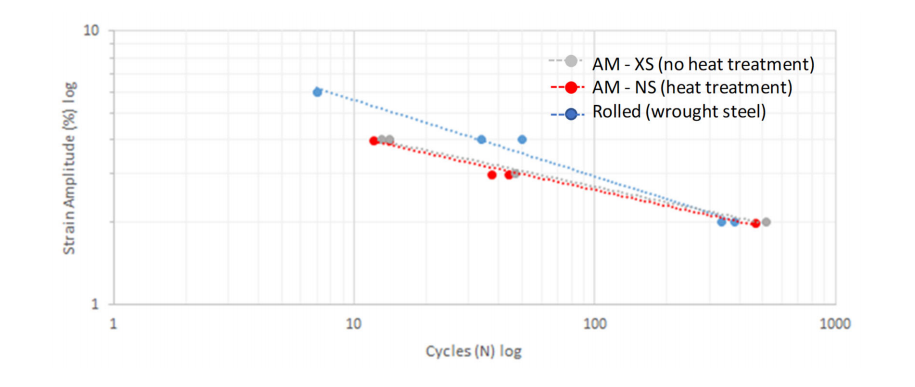Kaley Collins recently presented a thesis, ‘Extremely Low Cycle Fatigue Behavior of Additively Manufactured 17-4PH Stainless Steel,’ to the Department of Civil Engineering at the University of Arkansas. Researching the behavior of stainless steel and low cycle fatigue regimes, Collins explains that the goal of the thesis project was to develop strain-life curves to eliminate failure in metal structures.
In this study, the focus is on energy dissipating devices that allow structures to handle seismic load, standing up to catastrophic stress like earthquakes. With 3D printing and additive manufacturing processes at work in so many industrial applications today, users are benefiting from the many advantages of 3D printing, from greater affordability, speed, and efficiency, to the ability to create complex geometries not previously possible.
Centering around 17-4PH stainless steel, Collins compares seismic dissipation devices made through conventional methods as well as 3D printing. While the pros involved in 3D printing are often extolled, there are still many challenges to overcome as users take on new and innovative projects, as well as delving further into the functionality of complex parts rather than just rapid prototypes.
Internal defects continue to be a source of study for researchers around the world, hoping to eliminate issues with new tools, materials, monitoring systems, and more. In metal printing, voids can be the catalysts for failure, as well as ‘layered heat-affected’ areas that cause prints to weaken.
“A better understanding of how AM materials perform in the ELCF [extremely low-cycle fatigue] regime will provide an understanding of material performance during earthquake-type loadings and allow construction of optimized free-form geometries for earthquake dissipating devices,” explains Collins.
Fatigue loading for all experiments in the study was strain controlled, with samples stressed, running through cycles until the point of failure. Five samples (XS) were made by industry partners, explained the author, while the other eight (NS) were created at the National Institute of Standards and Technology. Before the research team removed them from the build plate, all NS specimens were heat treated—while XS specimens were not.
Controlled strain evaluations were performed with a servo-hydraulic fatigue testing machine, with the use of a knifeblade extensometer directly afterward to assess whether suitable strain ranges were applied.
For all samples, typical behavior resulted in necking and fracture after several inelastic cycles; however, upon the use of heat treatment, there were ‘no observable effects’ on ELCF behavior.Overall, AM 17-4PH stainless steel demonstrated a lower fatigue life versus the wrought 17- 4PH stainless steel as inelastic cyclic strains were performed.
“Voids and defects within the AM steel due to unmelted particles contributed to the reduction in fatigue life,” concluded Collins.
“AM 17-4PH stainless steel exhibits higher post-yield strain hardening that wrought 17-4PH stainless steel. Micro-hardness measurements within the grip and gauge sections of the specimens showed that the AM steel post-yield hardening differs from that of traditionally fabricated steels.”
What do you think of this news? Let us know your thoughts! Join the discussion of this and other 3D printing topics at 3DPrintBoard.com.
[Source / Images: ‘Extremely Low Cycle Fatigue Behavior of Additively Manufactured 17-4PH Stainless Steel’]Subscribe to Our Email Newsletter
Stay up-to-date on all the latest news from the 3D printing industry and receive information and offers from third party vendors.
You May Also Like
Air Force Awards Fortius Metals $1.25M to Qualify 3D Printing Wire for Hypersonic Applications
AFWERX, part of the US Air Force Research Laboratory (AFRL), awarded a Direct-to-Phase II Small Business Innovation Research (SBIR) contract worth $1.25 million to Colorado’s Fortius Metals, to accelerate qualification...
US Air Force Awards JuggerBot $4M for Large-format Hybrid 3D Printing
Large-format 3D printer manufacturer JuggerBot has received a $4 million grant to develop a large format 3D printer, courtesy of the Under Secretary of Defense, Research and Engineering Manufacturing Technology...
Where Have All AM’s Unicorns Gone?
In the rapidly evolving world of 3D printing, startups valued at over a billion dollars, known as unicorns, once seemed as fantastical as the mythical creatures themselves. While a few...
How My Childhood Fascination with Planes Led to Investing in 3D Printing
My fascination with aerospace started young, and I started studying planes–identifying them in the sky and learning everything I could about how they work. Fast forward to my first week...





































